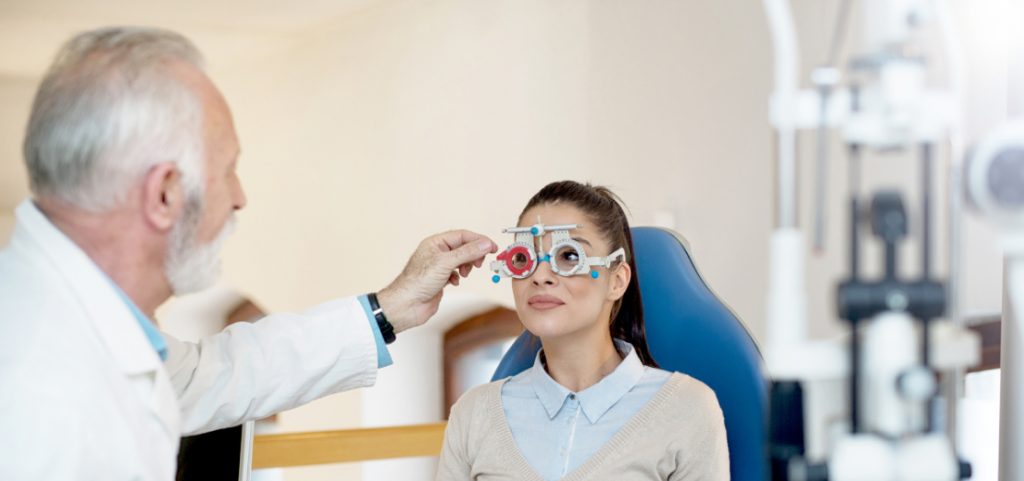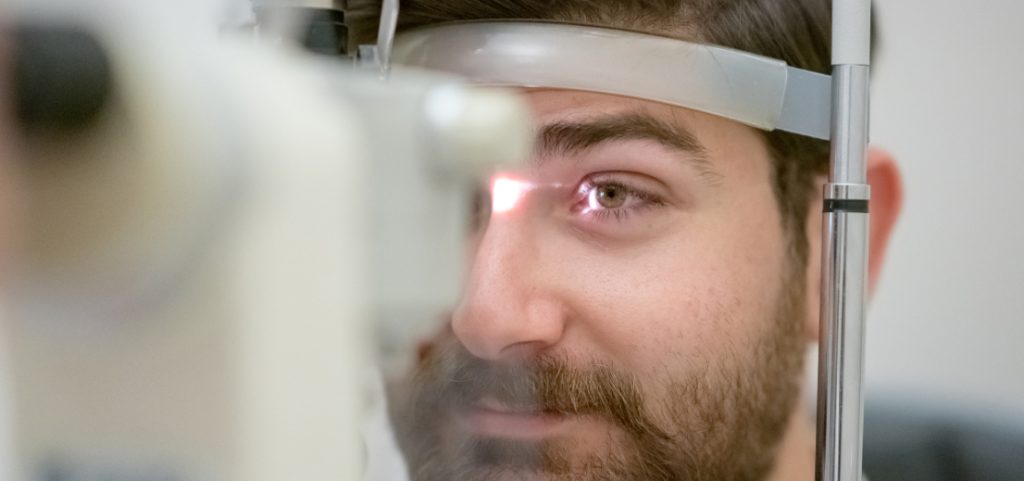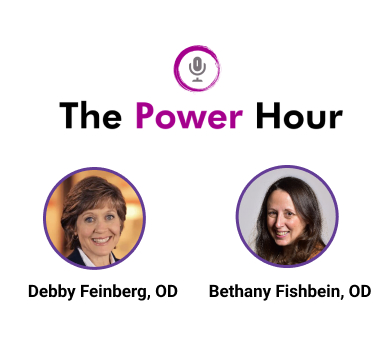What is Vertical Heterophoria?
Have you come across the term Vertical Heterophoria recently and felt a bit out of the loop?
NeuroVisual Medicine Institute
- 11 min read

History of Vertical Heterophoria
Vertical Heterophoria (VH) was first mentioned by Dr. George T. Stevens in 1887. He unsuccessfully tried to treat using large amounts of prism but was successful treating the condition with surgery. No one has been able to duplicate his results.
In the 1950s and 1960s, Dr. Raymond Roy discussed his treatment of VH in a series of 11 articles. His treatment included patching each eye for 6 days to determine the misalignment, but his methods were not well received by patients or eye care professionals and failed to become the standard of care.
Dr. Debby Feinberg diagnosed and treated her first patient with VH in 1995. In the past two decades, she has treated thousands of patients with the condition as well as being a pioneer in research-based screening techniques and treatment using microprism.
VH has been identified and discussed in optometric textbooks like Borish; however, previous understandings have failed to appreciate the clinical impact of microprism heterophorias, and previous testing techniques have failed to identify small amounts of vertical misalignment.
What is VH and its connection to BVD?
Binocular Vision Dysfunction (BVD) is a condition where the eyes have difficulty working in a coordinated manner, resulting in eye misalignment and even double vision. Many of these patients have suffered from symptoms their entire lives without a diagnosis.
VH is a BVD resulting from a vertical misalignment of the eyes. While being one of the most common types of BVD (estimated at 20% of the population 5), it is rarely diagnosed by clinicians. VH may be present from birth due to facial asymmetry or eye muscle abnormality or can be acquired due to stroke, brain injury or other neurological disorders.
Vertical misalignments as small as 0.25 diopters may result in many vestibular, and ocular and systemic symptoms which originate from the body’s attempt to correct for the error by overusing and straining the eye muscles or by tilting the head to realign the images.
There are two forms of vertical heterophoria: monocular and binocular. The monocular form is a malfunction of the visual system and is commonly recognized as a superior oblique palsy. A superior oblique palsy can be genetic or acquired in a head injury or due to poor blood supply in diabetes.
The binocular form appears to be a vestibular system problem, most likely due to faulty eye alignment signals sent from the vestibular system through the vestibular ocular reflex (VOR).
The visual system responds to impending diplopia (possibly through the fusional vergence reflex) by trying to align the two images. The faulty vestibular signal asserts itself again, which sets up a misalignment/realignment cycle at a rapid frequency and is the cause of the patient’s symptoms.
The overuse of the opposing elevator and depressor muscles trying to re-align the lines of sight results in muscle strain, headache, asthenopia, and eye pain with movement. The rapid misalignment/realignment cycle is hypothesized to cause visual shimmering or a sensation of image vibration, as well as dizziness, and other vestibular-type symptoms.
Most patients experience a head tilt, as this has the propensity to help bring vertically misaligned images closer together, but can cause neck and upper back pain.
What to Look Out for as an Optometrist
VH Symptoms and Physical Findings
Patients report a wide variety of symptoms which can make diagnosis more difficult. The two most common symptoms are headache and dizziness. Patients with BVD typically experience headaches in the front of the face or the temples. The dizziness is described as feeling disoriented or lightheaded.
Reading Symptoms of VH
Difficulty with reading and comprehension, words that blur or run together, skipping lines, and trouble concentrating are reported by patients with VH. The symptoms are like those experienced by patients with learning disabilities, dyslexia and even ADHD.

Pain Struggles/Symptoms
Patients with VH may suffer from pain in the upper back and neck caused by their head tilt. Pain may also be felt in the face, when moving their eyes or just general eye pain. Similarly, neck and back pain are often felt in patients with spinal misalignment and face/eye pain in those with TMJ problems, migraines, and sinus problems.
Binocular Vision Symptoms of VH
Patients with VH may have symptoms of overlapping or double vision, blurred or shadowed vision, difficulties with reflection or glare, and light sensitivity. While diplopic-type symptoms had been thought to be sine qua non for BVD, they are present in only about 1/3 of VH patients.
Routine Visual Symptoms
Patients may present with routine vision complaints like blur at distance or near, difficulty driving at night, eye strain or sore eyes.
Sleep Struggles/Symptoms
Patients with VH often have difficulty sleeping. Eyelids are only able to block part of the light even when they are closed, and a sleep mask can be used to improve sleep.
Neurological Symptoms of VH
Headaches are the most reported symptoms of VH. Patients with VH may also feel dizzy and have symptoms of vertigo and motion sickness.
Inner Ear / Vestibular Symptoms
Those with VH share similar symptoms with many inner ear disorders and Meniere’s disease. Patients report nausea, motion sickness, vertigo, instability when walking/drifting to a side, and poor coordination.
Driving Struggles/Symptoms
Symptoms of dizziness, light headedness, anxiety, or nausea may be experienced by patients with VH while driving a car. These pts tend to avoid the freeways, opting for driving only on surface roads.
Anxiety Symptoms
Patients often report feeling anxious in big crowds or unsettled in large, open areas with high ceilings like a mall, occasionally precipitating panic attacks. . Symptoms are similar to those reported by patients with agoraphobia or anxiety disorders.
Physical Findings of VH
There are five common physical findings that may be present in patients with VH:
- Vertical orbital asymmetry, with one orbit being visibly higher than the other. This is frequently a form of hemifacial microsomia.
- Forehead wrinkles above the physically higher eye
- The presence of a head tilt, which occurs to vertically realign images
- Trapezius muscle discomfort/pain, secondary to the head tilt
- Balance and gait instability – drifting to one side with ambulation, falling
Age Specific VH struggles
VH symptoms and patient struggles may vary by age. Children, youth and adults may each experience unique symptoms and some overlap of symptoms.
Children specific struggles/symptoms
VH is often undiagnosed in children. They are given a standard vision test at the pediatrician’s office to determine how each eye can see at distance, and only for a brief period of time. Both pediatric and school screenings fail to identify small amounts of misalignment, as well as near-vision problems. It is estimated that up to 50% of children diagnosed with ADD/ADHD and dyslexia may have small misalignments. Misalignments lead to difficulty with both reading and attention.
For children ages 4 to 8-years old, common VH symptoms and behaviors may include: clinging to their parents in social environments, poor handwriting, difficulty reading, frequently bumping into things, and difficulty catching balls.
Youth specific struggles/symptoms
Children aged 9 to 13 may exhibit common behaviors and symptoms of VH like difficulty completing homework due to headache and nausea, reading the same things repetitively for comprehension, frequent blinking, and have verbal skills ahead of their reading skills.
Adult specific struggles /symptoms
VH may affect up to 70% of adults who suffer from persistent headaches, 30% who suffer from anxiety and 30% who have symptoms post-concussion or TBI. Adults with VH may experience all or some of the symptoms of VH like headaches, migraines, frequent head tilt, and motion sickness.
Ready to Transform Your Patient’s Lives and
Your Practice?
Learn more about the benefits of adding a NeuroVisual specialty to your optometric practice.
How do patients experience Vertical Heterophoria?
Prior to VH diagnosis, patients are often referred to multiple providers in hopes of treatment for their symptoms. They have undergone numerous tests and tried many treatments and medications, and yet received little relief. Study data indicates that 92.1% of TBI patients reported headache, dizziness, or anxiety for an average duration of 9.9 years before diagnosis.
Before finding a NeuroVisual specialist, most had seen other physicians including general practice (68.4%), neurologists (60.5%), physiatrists (55.3%), psychiatrists or psychologists (36.8%), otolaryngologists (29.0%), and chiropractors (21.1%). 73.6% of the patients had been evaluated by an ophthalmologist or optometrist, but none had been diagnosed with VH prior to participation in a study by Feinberg et al.
Often, the symptoms of VH are not understood to be visual in origin, and the patient may not gain relief if the underlying cause of VH is not identified and referred to a NeuroVisual specialist. Many are diagnosed incorrectly with a variety of other conditions including, migraines (52.6%), sinus disorders (23.7%), vertigo (23.7%), anxiety (52.6%), and attention deficit disorder/attention deficit hyperactivity disorder (18.4%).
Idenfitying VH through a patient’s case history
Patients may report a wide variety of symptoms they have experienced their entire lives or may be the result of TBI. A thorough and comprehensive case history is key for diagnosis.
Approximately 5-10% of TBI patients develop persistent and long-term symptoms even after extensive injury rehab. Typical TBI symptoms overlap with those of VH including cephalgia, difficulty with balance, coordination, mobility, anxiety, and vision abnormalities. TBI patients with VH can be treated with microprism resulting in a 71.8% decrease in subjective symptoms and a relative reduction in their symptoms questionnaire score (BVDQ) of 48.1%.

Screening for VH
Screening for VH has been difficult in the past due to the variety of VH symptoms and a lack of standard scale to assess patient symptoms (Schroeder). Historical tests designed to detect and measure VH yields inaccurate results when compared to patient symptoms. Dissociated phoria tests do not consistently detect small vertical misalignments. The success of tests ranged from 16.2% (Von Graefe phoria – near) to approximately 64% (Von Graefe phoria – far and vertical vergence testing).
Why most ODs don’t screen for Heterophoria
There are several reasons that ODs do not screen for VH. Most ODs are unaware of the prevalence of the condition and how it may present. If they are, they are most likely uncomfortable with management and treatment. Techniques that optometrists were taught in school to assess VH are not precise enough and it may seem difficult to determine the amount of prism to prescribe. Private practice optometrists must also think about their cost of goods; prism glasses can be expensive to make and re-make if treatment is unsuccessful.
Most are also confined by vision vs. medical insurance, and the condition encompasses both. This battle is one daily fought in optometry offices. Furthermore, adding a speciality to the practice will need preparation prior to implementation. Most specialities require expensive equipment, staff time, and extensive training to implement. It can seem overwhelming. Our schedules are set, and staff operational in an efficient way to see routine vision patients and are not equipped to see out-of-the box patients.
How to identify patients with VH?
The Binocular Vision Dysfunction Questionnaire (BVDQ) is the best tool designed to identify patients who would benefit from a NeuroVisual evaluation. The BVDQ is a survey instrument developed and validated to screen for VH in patients with typical VCH symptoms, such as headache and dizziness. It may also be useful for measuring changes in VH symptom burden with various treatments, and in identifying the diverse symptoms associated with VH.
The 25-question BVDQ is a validated, self-administered survey developed to assess a comprehensive range of symptoms associated with VH. The screening tool accounts for the specific combination of symptoms, and degree of symptom frequency that are unique for each patient. This makes it useful as a brief, comprehensive screening tool for VH, and as a guide to the physician community to use to help them determine who to refer for evaluation of these difficult-to-treat patients. Internal consistency of the BVDQ is quite high (Cronbach alpha=1⁄4 0.91), as was test-retest reliability (r= 0.85, p < 0.01). The arrangement of symptoms represented in the BVDQ was consistent both within the set of questions included and over time.
The BVDQ has also demonstrated moderate correlation with the patients’ estimate of change in overall symptoms relative to treatment, which implies it may be used clinically for monitoring improvement over time.
Create more joy in your practice by changing lives!
Hear from Dr. Debby about a day-in-the-life of a NeuroVisual
Medicine Specialist. Help patients in a whole new way.
See fewer patients per day, while increasing revenue.
Uncovering Vision Misalignment
After a VH is suspected, patients undergo a NeuroVisual examination. Study data demonstrates that small amounts of microprism can be effective in reducing the symptoms of VH in patients presenting with headache, vestibular, and/or anxiety problems. Patients with a diagnosis of VH and who are treated with microprisms, experience an overall reduction of symptoms approximately 50% almost immediately. during the initial exam, and approximately 80% upon completion of treatment.
The amount of prescribed microprism is determined using the Prism Challenge technique. Small units of vertical prism (0.25D) are incrementally added over a patient’s subjective refraction. The direction of prism correction is based on other VH tests and the patient’s head posture/tilt. Patients are asked about acuity and comfort as the prism is added. After wearing the prism for 15-20 mins, patients are re-assessed.
The patient is then asked to wear the refraction with added prism for 2-4 weeks, and then return for 1-2 follow-up appointments for an adjustment to address any remaining symptoms.
Idenfitying VH through a patient’s case history
Patients may report a wide variety of symptoms they have experienced their entire lives or may be the result of TBI. A thorough and comprehensive case history is key for diagnosis.
Approximately 5-10% of TBI patients develop persistent and long-term symptoms even after extensive injury rehab. Typical TBI symptoms overlap with those of VH including cephalgia, difficulty with balance, coordination, mobility, anxiety, and vision abnormalities. TBI patients with VH can be treated with microprism resulting in a 71.8% decrease in subjective symptoms and a relative reduction in their symptoms questionnaire score (BVDQ) of 48.1%.

Conclusion
VH can have several etiologies and may present with an array of visual, systemic and neurological symptoms. Identification and effective treatment is key to addressing the needs of these patients. Small units of vertical prism can be used to alleviate the most common symptoms of headache, anxiety, and dizziness.
Sources:
Stevens, GT. Functional Nervous Diseases. New York, NY: D. Appleton and Company, 1887:200-203
Surdacki M, Wick B. Diagnostic occlusion and clinical management of latent hyperphoria. Optometry & Vision Science 1991; 68:261–269.
Roy RR. Ocular migraine and prolonged occlusion. Part 2. Optom Wkly 1953; 44:1513-1518.
Feinberg, D. Practice Profile: Vision Specialists of Michigan. The Case for Vertical Heterophoria Care. Accessed from https://www.optometricmanagement.com/issues/2019/october-2019/the-case-for-vertical-heterophoria-care
Feinberg DL, Rosner MS, Rosner AJ. Vertical heterophoria treatment ameliorates headache, dizziness, and anxiety). Optometry and Visual Performance. 2020 March; 8:1-33.
Jackson DN, Bedell HE. Vertical heterophoria and susceptibility to visually induced motion sickness. Strabismus. 2012;20(1):17-23. doi:10.3109/09273972.2011.650813
Feinberg DL, Rosner MS, Rosner AJ. Validation of the binocular vision dysfunction Questionnaire (BVDQ). Otol Neurotol. 2021 Jan;42(1):e66-e74. doi: 10.1097/MAO.0000000000002874. PMID: 33105328.
Rosner, M. S., Feinberg, D. L., Doble, J. E., & Rosner, A. J. (2016). Treatment of vertical heterophoria ameliorates persistent post-concussive symptoms: A retrospective analysis utilizing a multi-faceted assessment battery. Brain injury, 30(3), 311-317.
Doble, JE, Feinberg DL, Rosner MS, Rosner AJ. Identification of binocular vision dysfunction (vertical heterophoria) in traumatic brain injury patients and effects of individualized prismatic spectacle lenses in the treatment of postconcussive symptoms: a retrospective analysis. PM R. 2010 Apr;2(4):244-53. doi: 10.1016/j.pmrj.2010.01.011. PMID: 20430325.
Schroeder TL, Rainey BB, Goss DA, Grosvenor TP. Reliability of and comparisons among methods of measuring dissociated phoria. Optom Vis Sci. 1996 Jun;73(6):389-97. doi: 10.1097/00006324-199606000-00006. PMID: 8807650.
Scheiman, M., & Wick, B. (2002). Clinical management of binocular vision: Heterophoric, accommodative, and eye movement disorders. Philadelphia: Lippincott Williams & Wilkins.
Wick BB. Prescribing vertical prism: How low can you go? J Optom Vision Dev 1997;28:77-85


